语言学题
- 格式:docx
- 大小:16.51 KB
- 文档页数:1
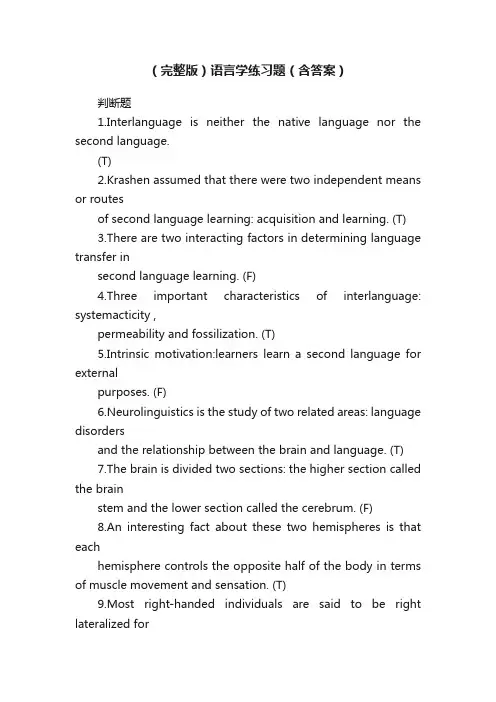
(完整版)语言学练习题(含答案)判断题1.Interlanguage is neither the native language nor the second language.(T)2.Krashen assumed that there were two independent means or routesof second language learning: acquisition and learning. (T)3.There are two interacting factors in determining language transfer insecond language learning. (F)4.Three important characteristics of interlanguage: systemacticity ,permeability and fossilization. (T)5.Intrinsic motivation:learners learn a second language for externalpurposes. (F)6.Neurolinguistics is the study of two related areas: language disordersand the relationship between the brain and language. (T)7.The brain is divided two sections: the higher section called the brainstem and the lower section called the cerebrum. (F)8.An interesting fact about these two hemispheres is that eachhemisphere controls the opposite half of the body in terms of muscle movement and sensation. (T)9.Most right-handed individuals are said to be right lateralized forlanguage. (F)10.C T scanning uses a narrow beam of X-ray to create brain images thattake the form of a series of brain slices. (T)11.1 Right hear advantage shows the right hemisphere is not superior forprocessing all sounds, but only for those that are linguistic in nature, thus providing evidence in support of view that the left side of the brain is specialized for language and that's where language centers reside. (f)12.2 Evidence in support of lateralization for language in left hemispherecomes from researches in Dichotic listening tasks(t)13.3interpersonal communications is the process of using languagewithin the individual to facilitate one’s own thought and aid the formulation and manipulation of concepts. (t)14.4 Linguistic lateralization is hemispheric specialization or dominancefor language. (t)15.5 Dichotic Listening is a research technique which has been used tostudy how the brain controls hearing and language, with which subjects wear earphones and simultaneously receive different sounds in the right or left ear, and are then asked to repeat what they hear.(f)16.6 Dichotic Listening is a research technique which has been used tostudy how the brain controls hearing and language, withwhich subjects wear earphones and simultaneously receive different soundsin the right and left ear, and are then asked to repeat what they hear.(t)17.7 Input refers to the language which a learner bears and receives andfrom which he or she can learn. (f)18.8 Fossilization ,a process that sometimes occurs in language learningin which incorrect linguistic features (such as the accent of a grammatical pattern) become a permanent part of the way a person speaks or writes in the target language.(f)19.9 The different languages have a similar level of complexity anddetail, and reflect general abstract properties of the common linguistic system is called Universal Grammar . (t)20.10 Acculturation a process of adapting to the culture and valuesystem of the second language community.(t)21.I n socialinguistic studies,speakers are not regarded as members ofsocial groups (F)22.n ew words maybe coined from already existing words by substractingan affix thought to be part of the old world (T)23.a ll languages make a distinction between the subject and directobject,which can be illustrated in word order (T)24.I t has been noticed that in many communities belanguage used bythe older generation differs from that used by the elder generation in certain ways (F)25.A pidgin is a special language variety that mixes or blends languagesand it isn’t used by people who speak different languages for restricted purposes such as trading(F)26.I t is interesting to know that the language used by men and womenhave some special features of others (F)27.I t is an obvious facts that people who claim to be speakers of thesame language don’t speak the language in the different manner (T)28.A regional dialect is a linguistic variety used by people living (T)29.F usion refers to this type of grammatication in which words developinto affixes (T)30.H istorical linguistics,as a branch of linguistics is mainly coverned withboth the description and explanation of language changes that occurred over time (T)选择题Chapter 71.Which one is not right about Blenging?(b)A:disco-discotheque B:brunch-breakfast+luchC:B2B-Business-to-Business D:videophone-video+cellphone2.Semantic changes contains three processes ,which one is ture?(a)A:namely widening ,narrowing and shift in meaningB:semantic broadening ,narrowing and semantic dispearing C:semantic shift ,narrowing and semantic lossingD:namely widening ,narrowing and not shift in meaning3.Science and technology influence English language in these aspects(d) A:space travelB:compnter and internet languageC:ecdogyD:above of all/doc/6712907809.html,nguage changes can be found at different linguistic levels,such as in the A:phonology and morphologyB:syntax and lexiconC:semantic component of the grammarD:ABC5,Morphological and syntactic change contianA:addition or loss of affixesB:change of word ordenC:change in regation ruleD:abrove of allChapter 81.Which is not Halliday's social variables that determine the register? (D) A:field of discourseB:tenor of discourseC:mode of discouseD:ethnic dialect2.Which is not dialectal varieties?(C)A:regional dialect and idiolectB:language and genderC:registerD:ethnic dialect3.To some extent,language especially the structure of its lexicon,refects___of a sociey.(C)A:physical B:social environmentC:both AandB D:social phenomenon4.____,refers to the linguistic variety characteristic of a particular social class.(D)A:Social-class dialect B:sociolectC:A andB D:A or B5.Two languages are used side by side with each having a ____role to play;and language switching occurs when the situation ____.(A)A:different,changesB:similar,changesC:different,unchangingD:similar,unchangingChapter 91.which is not the component of culture ?/doc/6712907809.html,nguageB.ideasC.beliefD.soil2.in a word,language expressA.factsB.events which represent similar world knowledge by its peopleC.peoples' attitudes.beliefsD.cultural reality3.any linguistic sign may simultaneously have aA.denotativeB.connotativeC.iconicD.denotative,connotative,or iconic kind of meanings4.what's the meaning of"a lucky dog"in english?A.a clever boyB.a smart ladC.a lucky personD.a silent person5.traditionally,curture contact consists of three forms.which is wrong belowA.acquisitionB.acculturationC.assimilationD.amalgamation Chapter 101.The interavtionist view holds that language as a result of the complex interplay between the___A__of a child and the __A__in which he grows .A: human chracteristics environmentB: chracteristics environmentC: language acquisition placeD: gift place2.The atypical language development includes__A___A: hearing impairment mental retardationB: autism stutteringC: aphasia dyslexia dysgraphiaD: Both A ,B and C3.Children's language learning is not complete by the time when they enter school at the age of _C__A: 3 or 4 B: 4 or 5C: 5 or 6 D: 6or 7Chapter 111.A distinction was made between ( ) and ( ).The former would facilitate target language learning,the later would interfere. < A >A positive transfer negative transferB negative transfer positive transferC contrastive analysis error analysisD error analysis contrastive analysis2.( ) are learners' consious,goal-oriented and problem-solving based efforts to cahieve desierable learning efficiency. < A >A Learning strategiesB Cognitive strategiesC Metacognitive strategiesD Affect strategies/doc/6712907809.html,nguage acquisition device(LAD) came from( ). < D >A John B.WatsonB B.F. SkinnerC S.D. KrashenD ChomskyChapter 121.____is the study of two related areas:language disorders and the relationship between the brainand language.A.neurolinguisticsB.linguisticsC.neuronsD.modern linguistics2.Psycholingusitics is the study of _____and mental activityassociated with the use of languageA.psychobiologyB.psychological statesC.physical statesD.biological states3._____uses a narrow beam of X-ray to create brain images that the form of a series of brainslices.A.PETB.MRIC.CT scanningD.fMRI4.The brain is divided into two sections:the lower section called the____and the higher sectioncalled____.A.brain stem,cerebrumB.brain stem,neuronsC.cerebrum,brain stemD.cerebrum,neurons5.Damage to parts of the left cortex behind the central sulcus results in a type of aphasia called_____.A.Wernicke's aphasiaB.Broca'saphasiaC.Acquires dyslexiaD.fluent aphasia填空题第七章1.In addition to the borrowed affixes,some lexical forms become grammaticalized over time,this process is called______________2.Generally speaking,there are mainly two possible ways of lexical changes: ________and ________,which often reflects the introduction of new objects and notions in social practices.3.New words may be coined from already existing words by "subtracting"an affix thought t be part of the old word ,such words are thus called____________.4.Over the time many words remain in use,but their meanings have changed,three mainly processes of semantic change,___________,____________, ____________.5.While the "_________"and "__________ "do seem to account for some linguistic changes,it may not be explanatory enough to account for other changes.KEYS:1.grammaticalization2.the addition and loss of words3.back-formation4.widening, narrowing, shift5.theory of least effort, economy of memory第八章1·-------is the sub-field of linguistics that studies the relation between language and society,between the uses of language and the social structures in which the users of language live. 答案Sociolinguistics 2·The social group that is singled out for any special study is called th e ----------.答案speech community 3A------------is a linguistic variety used by people living in the same geographical region.答案regional dialect4he Ttype of language which is selected as appropriate to the type of situation is a---------.答案register5A-------is a special language variety thatmixes or blends languages ang it is used by people who speak different languages for restricted purposes such as trading.答案pidgin 第九章1. anguage and culture,intrinsically interdependent on each other,have_through history (evolved together)2. ulture reflects a total way of life of a people in a_(community)3.in a word,_expreses culture reality (language)4.culture differences are also evident in the way_ and compliments are expressed (gratitude)/doc/6712907809.html,nguage as the_of culture is tightly intertwined with culture (keystone) 第十章1 ( ) refers to a child’s acquisition of his mother tongue.2 Generally speaking, there are mainly three different theories concerning how language is learned,namely the behaviorist,the interactionist ,( ) views.3 All child language acquisition theories talk about the roles of twofactors to different degrees the age ang ( ).4 Lexical contrast and ( ) theories are also proposed to explain how children acquire their vocabulary or lexicon.5 The atypical language development includes hearing impairment,mental retardation, autism,stuttering,( ),dyslexia,dysgraphia.答案:/doc/6712907809.html,nguage acquisition2.the innatist3.the linguistic environment4.prototype5.aphasia第十一章1.()refers to the systematic study of how one person acquiresa second language subsequent to his native language (NL or L1) .2.Contrastive analysis compares the ( ) cross these twolanguages to locate the mismatches or differences so that people can predict the possible learning difficulty learners may encounter .3.In addition, because of its association with an outdated modellanguage description (structuralism) and the increasingly discredited learning theory (behaviorism) , the once predominant contrastive analysis was gradually replaced by ( ).4.The interlingual errors mainly result from ()interferenceat different levels such as phonological , lexical , grammatical ordiscoursal , etc .5.Krashen assumed that there were two independent means or routesof second language learning : acquisition and ()。
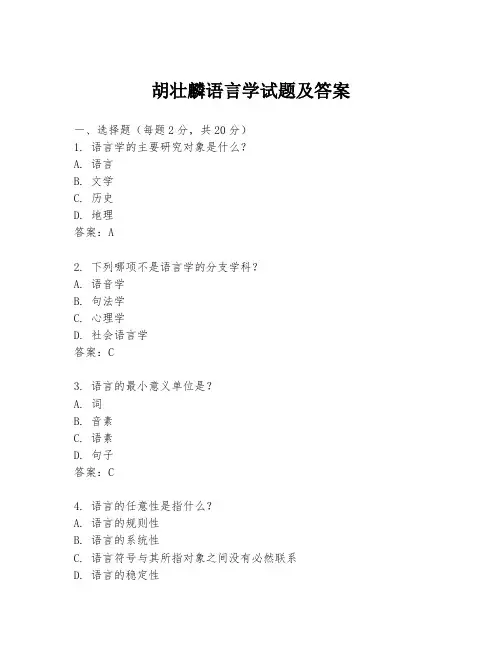
胡壮麟语言学试题及答案一、选择题(每题2分,共20分)1. 语言学的主要研究对象是什么?A. 语言B. 文学C. 历史D. 地理答案:A2. 下列哪项不是语言学的分支学科?A. 语音学B. 句法学C. 心理学D. 社会语言学答案:C3. 语言的最小意义单位是?A. 词B. 音素C. 语素D. 句子答案:C4. 语言的任意性是指什么?A. 语言的规则性B. 语言的系统性C. 语言符号与其所指对象之间没有必然联系D. 语言的稳定性答案:C5. 以下哪项是语言的双重性?A. 语言的任意性B. 语言的稳定性C. 语言的双重性D. 语言的系统性答案:D6. 语言的演变遵循什么规律?A. 经济原则B. 社会原则C. 心理原则D. 所有以上答案:D7. 语言的功能不包括以下哪项?A. 信息传递B. 情感表达C. 艺术创作D. 物理治疗答案:D8. 语言的方言是指?A. 同一语言内部的变体B. 不同语言之间的相似性C. 语言的书面形式D. 语言的口头形式答案:A9. 语言的层级结构包括哪些?A. 音素、语素、词、短语、句子B. 词、短语、句子C. 语素、词、短语D. 音素、词、短语答案:A10. 语言的交际功能包括哪些?A. 表达、理解B. 表达、理解、记忆C. 表达、理解、记忆、创造D. 表达、理解、记忆、创造、评价答案:A二、填空题(每题2分,共20分)1. 语言学的创始人是________。
答案:费迪南·德·索绪尔2. 语言的两个基本功能是________和________。
答案:表达、理解3. 语言的________性是语言学研究的重要内容。
答案:任意性4. 语音学研究的是语言的________。
答案:声音系统5. 句法学研究的是语言的________。
答案:结构规则6. 社会语言学研究的是语言与________之间的关系。
答案:社会7. 语言的________性是语言变化的动力之一。
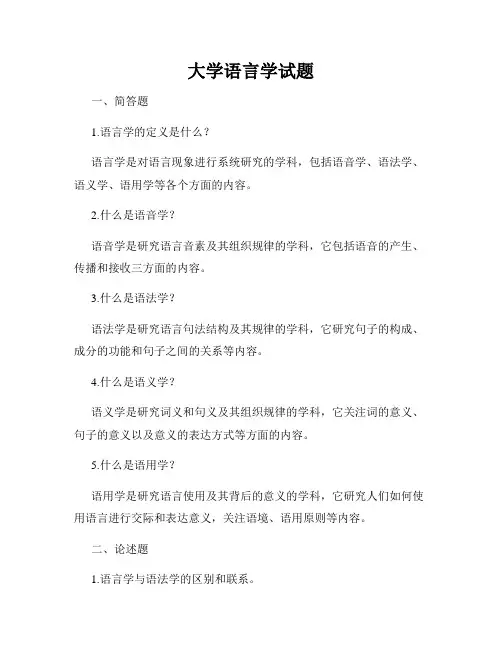
大学语言学试题一、简答题1.语言学的定义是什么?语言学是对语言现象进行系统研究的学科,包括语音学、语法学、语义学、语用学等各个方面的内容。
2.什么是语音学?语音学是研究语言音素及其组织规律的学科,它包括语音的产生、传播和接收三方面的内容。
3.什么是语法学?语法学是研究语言句法结构及其规律的学科,它研究句子的构成、成分的功能和句子之间的关系等内容。
4.什么是语义学?语义学是研究词义和句义及其组织规律的学科,它关注词的意义、句子的意义以及意义的表达方式等方面的内容。
5.什么是语用学?语用学是研究语言使用及其背后的意义的学科,它研究人们如何使用语言进行交际和表达意义,关注语境、语用原则等内容。
二、论述题1.语言学与语法学的区别和联系。
语言学是对语言现象进行全面研究的学科,涵盖了语音学、语法学、语义学和语用学等方面的内容。
而语法学是语言学的一个分支,主要研究语法现象及其规律。
语言学与语法学的联系在于语法学是语言学的重要组成部分,它提供了研究语言结构和规律的方法和理论基础。
同时,语法学的研究结果也为语言学的其他方面提供了重要的参考。
然而,语言学与语法学的区别在于语言学更加宏观和综合,它研究语言的各个方面,包括语音、词汇、句法、语义和语用等。
而语法学则是语言学中具体研究句法现象的一个分支,着重研究句子的构成、成分的功能和句子之间的关系。
2.语音学与音系学的关系。
语音学研究语音的产生、传播和接收,它是语言学的一个重要分支学科。
而音系学则是语音学中研究语言音素及其组织规律的一个分支领域。
语音学通过观察和记录语音现象,研究不同语音之间的差异和共性。
而音系学则在此基础上进一步研究语言中的音素及其分类、组织以及声音之间的相互关系。
简言之,语音学是对语音现象的整体研究,而音系学是语音学中对语音结构及其规律的具体研究。
三、分析题1.什么是语言的意义?语言的意义是指语言表达所传递的信息内容。
它涉及词汇意义、句子意义和话语意义等多个层次。
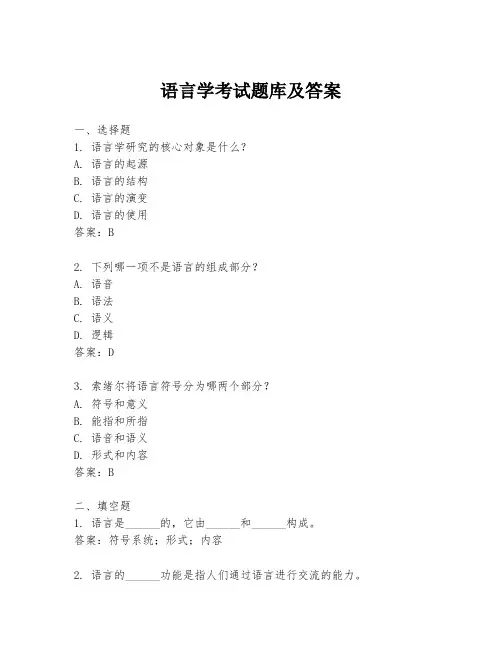
语言学考试题库及答案一、选择题1. 语言学研究的核心对象是什么?A. 语言的起源B. 语言的结构C. 语言的演变D. 语言的使用答案:B2. 下列哪一项不是语言的组成部分?A. 语音B. 语法C. 语义D. 逻辑答案:D3. 索绪尔将语言符号分为哪两个部分?A. 符号和意义B. 能指和所指C. 语音和语义D. 形式和内容答案:B二、填空题1. 语言是______的,它由______和______构成。
答案:符号系统;形式;内容2. 语言的______功能是指人们通过语言进行交流的能力。
答案:交流3. 语言的______功能是指语言能够表达思想和情感的能力。
答案:表达三、简答题1. 简述语言和言语的区别。
答案:语言是指一种抽象的符号系统,它包括语音、语法、语义等规则和结构;言语则是指个人使用语言进行交流的具体行为。
2. 描述索绪尔的“能指”和“所指”概念。
答案:索绪尔认为语言符号由“能指”和“所指”两部分组成。
“能指”指的是语言符号的声音形式,而“所指”指的是符号所代表的概念或意义。
四、论述题1. 论述语言的任意性原则及其对语言学习和教学的影响。
答案:语言的任意性原则指的是语言符号的声音形式和它所代表的概念之间没有必然的联系。
这一原则对语言学习和教学有着深远的影响,因为它意味着学习者需要记忆每个符号的声音和意义之间的联系,而不能依赖于逻辑或直观的关联。
这对语言教学提出了挑战,要求教师设计有效的教学方法来帮助学生记忆和理解这些任意的联系。
2. 分析语言的交际功能及其在现代社会中的重要性。
答案:语言的交际功能是指语言作为交流工具,使人们能够传递信息、表达情感和进行社会互动。
在现代社会,随着全球化和信息技术的发展,语言的交际功能变得尤为重要。
有效的沟通能够促进国际合作、文化交流和商业交易,同时也有助于解决社会冲突和增进理解。
因此,掌握一门或多门语言对于个人和社会的发展至关重要。
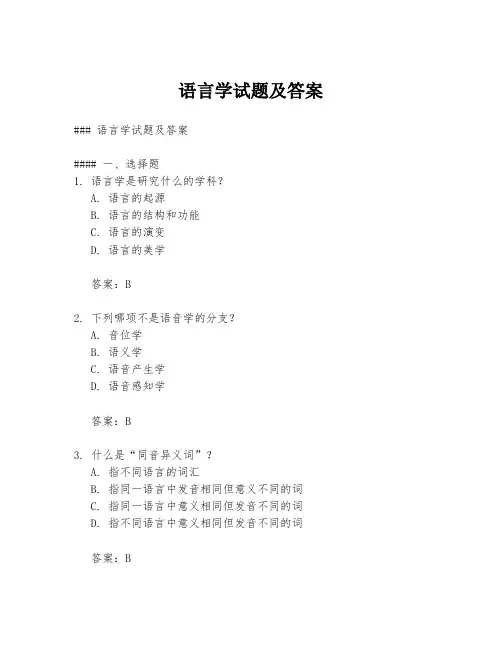
语言学试题及答案### 语言学试题及答案#### 一、选择题1. 语言学是研究什么的学科?A. 语言的起源B. 语言的结构和功能C. 语言的演变D. 语言的美学答案:B2. 下列哪项不是语音学的分支?A. 音位学B. 语义学C. 语音产生学D. 语音感知学答案:B3. 什么是“同音异义词”?A. 指不同语言的词汇B. 指同一语言中发音相同但意义不同的词C. 指同一语言中意义相同但发音不同的词D. 指不同语言中意义相同但发音不同的词答案:B#### 二、填空题4. 语言学的一个主要分支是________,它研究语言的意义。
答案:语义学5. 一种语言的语法规则可以描述该语言的________。
答案:结构6. 语言学中的“方言”指的是________。
答案:同一语言内部的地域性变体#### 三、简答题7. 简述语言的任意性原则。
答案:语言的任意性原则是指语言符号和它所代表的概念之间没有必然的逻辑或自然联系,这种关系是任意的,由社会约定俗成。
8. 什么是转换生成语法?答案:转换生成语法是一种语言学理论,由诺姆·乔姆斯基提出,主张语言的深层结构可以通过转换规则生成表层结构,从而解释语言的生成能力和多样性。
#### 四、论述题9. 论述语言和文化之间的关系。
答案:语言和文化是相互影响和塑造的。
语言不仅是文化的载体,通过语言可以传递文化信息和价值观;同时,文化也影响语言的使用和发展,如特定的社会习俗和信仰体系会影响语言的表达方式和词汇选择。
语言和文化共同构成了人类社会的认知和交流模式。
10. 描述语言习得的关键阶段及其特点。
答案:语言习得的关键阶段包括婴儿期、儿童早期和青少年期。
婴儿期是语言感知能力的发展阶段,儿童能够区分不同语言的音素。
儿童早期是语言习得的快速发展期,儿童开始学习语法规则并形成基本的语言能力。
青少年期则是语言习得的完善阶段,青少年继续扩展词汇量,提高语言运用的复杂性和准确性。
以上试题及答案涵盖了语言学的基础概念、理论以及与语言习得和文化的关系,旨在考察学生对语言学核心知识的掌握和理解。
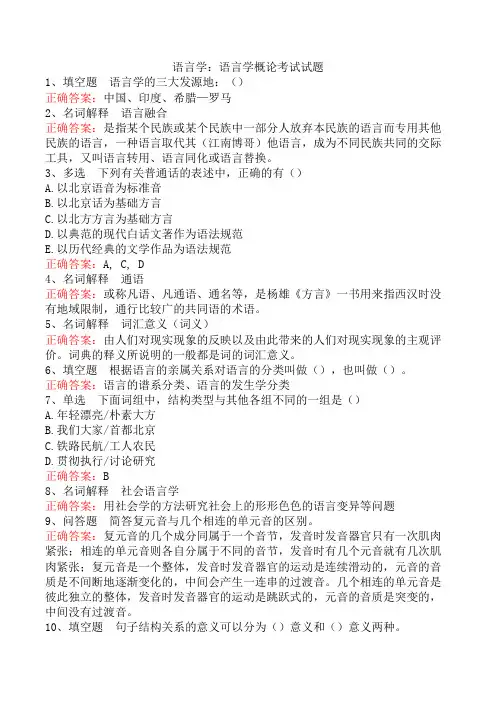
语言学:语言学概论考试试题1、填空题语言学的三大发源地:()正确答案:中国、印度、希腊—罗马2、名词解释语言融合正确答案:是指某个民族或某个民族中一部分人放弃本民族的语言而专用其他民族的语言,一种语言取代其(江南博哥)他语言,成为不同民族共同的交际工具,又叫语言转用、语言同化或语言替换。
3、多选下列有关普通话的表述中,正确的有()A.以北京语音为标准音B.以北京话为基础方言C.以北方方言为基础方言D.以典范的现代白话文著作为语法规范E.以历代经典的文学作品为语法规范正确答案:A, C, D4、名词解释通语正确答案:或称凡语、凡通语、通名等,是杨雄《方言》一书用来指西汉时没有地域限制,通行比较广的共同语的术语。
5、名词解释词汇意义(词义)正确答案:由人们对现实现象的反映以及由此带来的人们对现实现象的主观评价。
词典的释义所说明的一般都是词的词汇意义。
6、填空题根据语言的亲属关系对语言的分类叫做(),也叫做()。
正确答案:语言的谱系分类、语言的发生学分类7、单选下面词组中,结构类型与其他各组不同的一组是()A.年轻漂亮/朴素大方B.我们大家/首都北京C.铁路民航/工人农民D.贯彻执行/讨论研究正确答案:B8、名词解释社会语言学正确答案:用社会学的方法研究社会上的形形色色的语言变异等问题9、问答题简答复元音与几个相连的单元音的区别。
正确答案:复元音的几个成分同属于一个音节,发音时发音器官只有一次肌肉紧张;相连的单元音则各自分属于不同的音节,发音时有几个元音就有几次肌肉紧张;复元音是一个整体,发音时发音器官的运动是连续滑动的,元音的音质是不间断地逐渐变化的,中间会产生一连串的过渡音。
几个相连的单元音是彼此独立的整体,发音时发音器官的运动是跳跃式的,元音的音质是突变的,中间没有过渡音。
10、填空题句子结构关系的意义可以分为()意义和()意义两种。
正确答案:显性;隐性11、名词解释单纯字符正确答案:不能再分解为更小字符的字符。
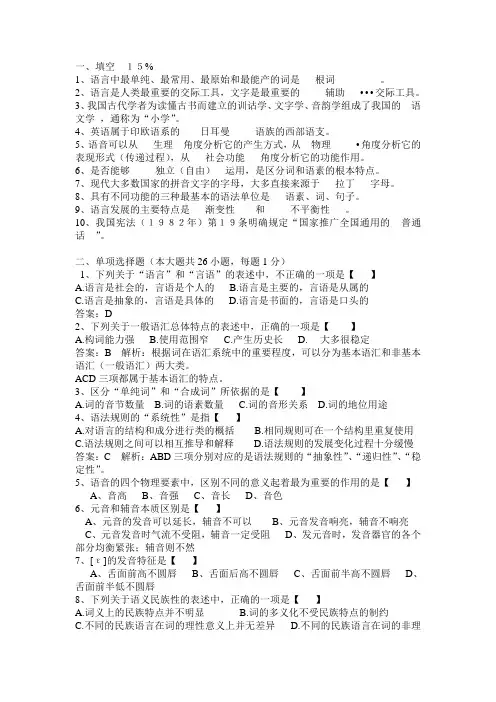
一、填空15%1、语言中最单纯、最常用、最原始和最能产的词是根词。
2、语言是人类最重要的交际工具,文字是最重要的辅助•••交际工具。
3、我国古代学者为读懂古书而建立的训诂学、文字学、音韵学组成了我国的语文学,通称为“小学”。
4、英语属于印欧语系的日耳曼语族的西部语支。
5、语音可以从生理角度分析它的产生方式,从物理•角度分析它的表现形式(传递过程),从社会功能角度分析它的功能作用。
6、是否能够独立(自由)运用,是区分词和语素的根本特点。
7、现代大多数国家的拼音文字的字母,大多直接来源于拉丁字母。
8、具有不同功能的三种最基本的语法单位是语素、词、句子。
9、语言发展的主要特点是渐变性和不平衡性。
10、我国宪法(1982年)第19条明确规定“国家推广全国通用的普通话”。
二、单项选择题(本大题共26小题,每题1分)1、下列关于“语言”和“言语”的表述中,不正确的一项是【】A.语言是社会的,言语是个人的B.语言是主要的,言语是从属的C.语言是抽象的,言语是具体的D.语言是书面的,言语是口头的答案:D2、下列关于一般语汇总体特点的表述中,正确的一项是【】A.构词能力强B.使用范围窄C.产生历史长D. 大多很稳定答案:B 解析:根据词在语汇系统中的重要程度,可以分为基本语汇和非基本语汇(一般语汇)两大类。
ACD三项都属于基本语汇的特点。
3、区分“单纯词”和“合成词”所依据的是【】A.词的音节数量B.词的语素数量C.词的音形关系D.词的地位用途4、语法规则的“系统性”是指【】A.对语言的结构和成分进行类的概括B.相同规则可在一个结构里重复使用C.语法规则之间可以相互推导和解释D.语法规则的发展变化过程十分缓慢答案:C 解析:ABD三项分别对应的是语法规则的“抽象性”、“递归性”、“稳定性”。
5、语音的四个物理要素中,区别不同的意义起着最为重要的作用的是【】A、音高B、音强C、音长D、音色6、元音和辅音本质区别是【】A、元音的发音可以延长,辅音不可以B、元音发音响亮,辅音不响亮C、元音发音时气流不受阻,辅音一定受阻D、发元音时,发音器官的各个部分均衡紧张;辅音则不然7、[ε]的发音特征是【】A、舌面前高不圆唇B、舌面后高不圆唇C、舌面前半高不圆唇D、舌面前半低不圆唇8、下列关于语义民族性的表述中,正确的一项是【】A.词义上的民族特点并不明显B.词的多义化不受民族特点的制约C.不同的民族语言在词的理性意义上并无差异D.不同的民族语言在词的非理性意义上会有所不同答案:D解析:不同民族对客观事物的认识不同,因而语义的民族特点也不同,词的多义化也会受制约,非理性意义也会有所不同,比如汉语中“狗”字常含贬义,像“走狗”;可在英语里,“dog”常含褒义,像“a lucky dog”(幸运儿)。
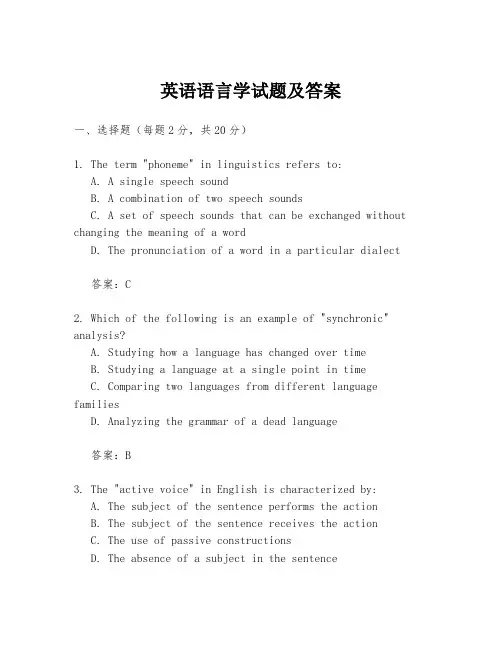
英语语言学试题及答案一、选择题(每题2分,共20分)1. The term "phoneme" in linguistics refers to:A. A single speech soundB. A combination of two speech soundsC. A set of speech sounds that can be exchanged without changing the meaning of a wordD. The pronunciation of a word in a particular dialect答案:C2. Which of the following is an example of "synchronic" analysis?A. Studying how a language has changed over timeB. Studying a language at a single point in timeC. Comparing two languages from different language familiesD. Analyzing the grammar of a dead language答案:B3. The "active voice" in English is characterized by:A. The subject of the sentence performs the actionB. The subject of the sentence receives the actionC. The use of passive constructionsD. The absence of a subject in the sentence答案:A4. Which of the following sentence structures is considered "inverse"?A. Subject-Verb-ObjectB. Object-Subject-VerbC. Verb-Object-SubjectD. Subject-Object-Verb答案:B5. The process of "creolization" results in the formation of:A. A pidginB. A dialectC. A creoleD. A standard language答案:C6. In English, the word "run" can function as:a. A nounb. A verbc. An adjectived. All of the above答案:D7. The term "register" refers to:A. The highest pitch a voice can reachB. A dialect used by a particular social groupC. The level of formality in language useD. A type of linguistic accent答案:C8. The "universal grammar" hypothesis was proposed by:A. Noam ChomskyB. B.F. SkinnerC. Ferdinand de SaussureD. Edward Sapir答案:A9. The "allophone" of the English phoneme /p/ in the word "spin" is:A. Aspirated [pʰ]B. Unaspirated [p]C. Voiced [b]D. Voiceless [p]答案:A10. The linguistic concept of "polysemy" refers to:A. The use of a single word to express multiple meaningsB. The use of multiple words to express a single meaningC. The change in meaning of a word over timeD. The complete replacement of one word by another答案:A二、填空题(每题2分,共20分)1. The study of language in relation to the brain and the nervous system is known as __________.答案:neurolinguistics2. A(n) __________ is a word that has a meaning and stands alone, typically consisting of a single morpheme.3. The __________ of a word is the set of words that are used together with it and influence its meaning.4. In linguistics, __________ refers to the smallest unit of meaning in a language.5. The __________ is the standard form of a verb that is typically used when conjugating the verb in the present tense.6. A(n) __________ is a word that is formed from a root word and one or more affixes.7. The __________ is the study of the historical developmentof languages.8. The __________ is the systematic study of the structureand function of words.9. The __________ is the study of the way in which languages change over time due to contact with other languages.10. The __________ is the branch of linguistics that studies the sounds of a language and how they function in a system ofcommunication.三、简答题(每题10分,共30分)1. 描述语音学中的“最小对立对”概念,并给出一个英语例子。
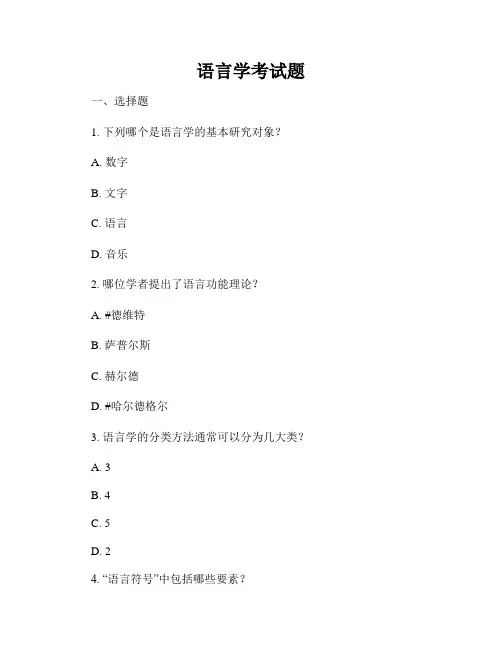
语言学考试题一、选择题1. 下列哪个是语言学的基本研究对象?A. 数字B. 文字C. 语言D. 音乐2. 哪位学者提出了语言功能理论?A. #德维特B. 萨普尔斯C. 赫尔德D. #哈尔德格尔3. 语言学的分类方法通常可以分为几大类?A. 3B. 4C. 5D. 24. “语言符号”中包括哪些要素?A. 声音B. 符号C. 拼写D. A、B5. 在语法范畴中,“动宾关系”是指什么?A. 主语和谓语之间的语法关系B. 主语和宾语之间的语法关系C. 宾语和谓语之间的语法关系D. 主语和动词之间的语法关系二、填空题6. 语言学中研究音素的学科是---。
7. 没有逻辑意义的音节称为---。
8. 语音学的基本单位是---。
9. 下列哪个不是语言学的分支学科?10. 一种语言中声母、韵母和声调三者综合的组合称为---。
三、简答题11. 请简要说明音韵学和语音学的区别。
12. 什么是“方言”,方言和语言的关系是什么?13. 什么是语法,语法的作用是什么?14. “文字和语言的关系”是语言学中一个重要问题,请简述你对这个问题的理解。
15. 请简要介绍语言学的研究方法有哪些?四、论述题16. 语言是人类最重要的交流工具之一,请说明语言对个体和社会的重要性。
17. 语言学的发展历程是怎样的?过去、现在和未来的语言学会有怎样的发展趋势?18. 请解释语言与文化之间的关系,并谈谈语言多样性对世界文化的重要影响。
以上便是本次语言学考试题的全部内容,请同学们认真地完成每一道题目,祝大家取得优异的成绩!。
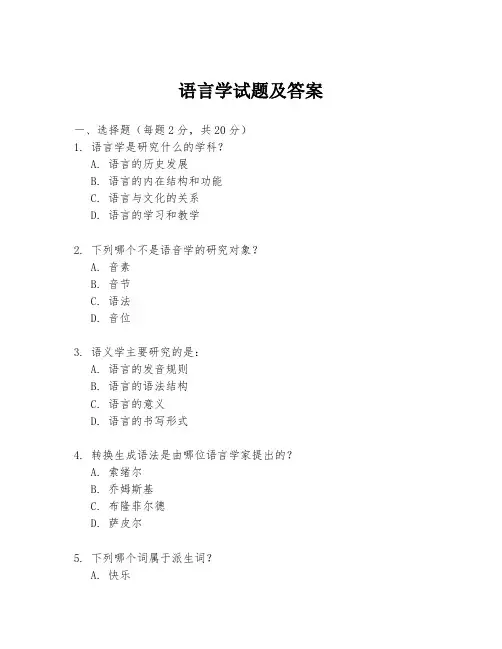
语言学试题及答案一、选择题(每题2分,共20分)1. 语言学是研究什么的学科?A. 语言的历史发展B. 语言的内在结构和功能C. 语言与文化的关系D. 语言的学习和教学2. 下列哪个不是语音学的研究对象?A. 音素B. 音节C. 语法D. 音位3. 语义学主要研究的是:A. 语言的发音规则B. 语言的语法结构C. 语言的意义D. 语言的书写形式4. 转换生成语法是由哪位语言学家提出的?A. 索绪尔B. 乔姆斯基C. 布隆菲尔德D. 萨皮尔5. 下列哪个词属于派生词?A. 快乐B. 快速C. 快乐地D. 快车6. 句法学研究的是:A. 句子的构成B. 词义的组合C. 语言的发音D. 语言的书写7. 社会语言学关注的是:A. 语言的变异与变化B. 语言与社会的关系C. 语言的起源和发展D. 语言的标准化8. 语言的功能主义理论是由下列哪位语言学家提出的?A. 索绪尔B. 乔姆斯基C. 韩礼德D. 布隆菲尔德9. 语言的同源词是指:A. 同一种语言中的不同词B. 不同语言中意义相同的词C. 来自同一词根的词D. 不同语言中发音相同的词10. 下列哪项不是语用学的研究内容?A. 语境B. 言语行为C. 语言的逻辑结构D. 语言的交际功能答案:1-5 B C C B D 6-10 A C B C C二、填空题(每题1分,共10分)1. 语言学的四个主要分支是语音学、语法学、语义学和________。
2. 索绪尔是________语言学的创始人。
3. 语言的任意性原则是指语言符号的_______和_______之间没有必然的联系。
4. 词类转换是指通过改变词的形式来改变其_______。
5. 语言的同化现象是指不同语言在交流中逐渐_______的现象。
6. 语言的方言是指同一语言内部由于_______、_______等因素而形成的不同变体。
7. 语言的借词是指一种语言从另一种语言中借用的_______或_______。
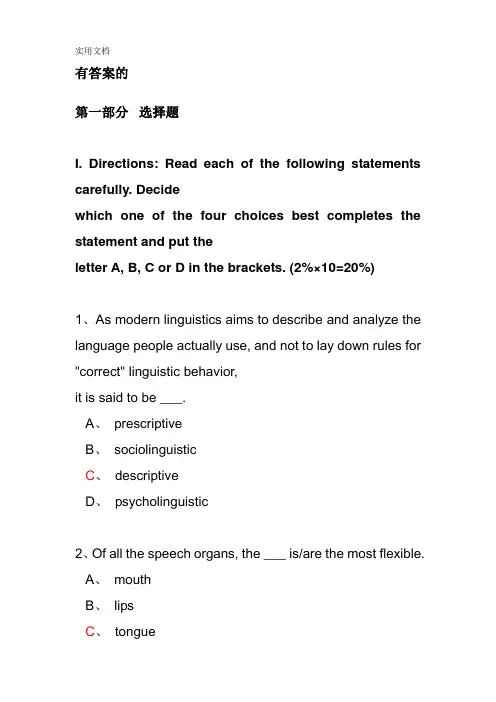
有答案的第一部分选择题I. Directions: Read each of the following statements carefully. Decidewhich one of the four choices best completes the statement and put theletter A, B, C or D in the brackets. (2%×10=20%)1、As modern linguistics aims to describe and analyze the language people actually use, and not to lay down rules for "correct" linguistic behavior,it is said to be ___.A、prescriptiveB、sociolinguisticC、descriptiveD、psycholinguistic2、Of all the speech organs, the ___ is/are the most flexible.A、mouthB、lipsC、tongueD、vocal cords3、The morpheme "vision" in the common word "television" is a(n) ___.A、bound morphemeB、bound formC、inflectional morphemeD、free morpheme4、A ___ in the embedded clause refers to the introductory word thatintroduces the embedded clause.A、coordinatorB、particleC、prepositionD、subordinator主从连词5、"Can I borrow your bike?" ___ "You have a bike."A、is synonymous withB、is inconsistent withC、entailsD、presupposes6、The branch of linguistics that studies how context influences the way speakers interpret sentences is called ___.A、semanticsB、pragmaticsC、sociolinguisticsD、psycholinguistics7、Grammatical changes may be explained, in part, as analogic changes, which are ___ or generalization泛化.A、elaborationB、simplification精简C、external borrowingD、internal borrowing8、___ refers to a marginal language of few lexical items and straightforward grammatical rules, used as a medium of communication.A、Lingua franca通用语B、CreoleC、PidginD、Standard language标准语言9、Psychologists, neurologists and linguists have concluded that, in addition to the motor area which is responsible for physical articulation of utterances, three areas of the left brain are vital to language, namely, ___ .A、Broca's area, Wernicke's area and the angular gyrus 角回B、Broca's area, Wernicke's area and cerebral cortexC、Broca's area, Wernicke's area and neuronsD、Broca's area, Wernicke's area and Exner's area10、According to Krashen, ___ refers to the gradual and subconcious development of ability in the first language by using it naturally in daily communicative situations.A、learningB、competenceC、performanceD、acquisition第二部分非选择题II. Directions: Fill in the blank in each of the following statements with one word, the first letter of which is already given as a clue. Note that you are to fill in One word only, and you are not allowed to change theletter given. (1%×10=10%)11、Chomsky defines "competence" as the ideal user'sk of the rules of his language.12、The four sounds /p/,/b/,/m/ and /w/have one feature in common, i.e, they are all b .13、M is a branch of grammar which studies the internal structure of words and the rules by which words are formed.14、A s is a structurally independent unit that usually comprises a number of words to form a completestatement, question or command.15、Synonyms that are mutually substitutable under allcircumstances are called c synonyms.16、The illocutionary point of r is to commit the speaker tosomething's being the case, to the truth of what has been said.17、Words are created outright to fit some purpose. Such a method of enlarging the vocabulary is known as word c .18、Wherever the standard language can use a contraction (he+is→he's), Black English can d the form of "be".19、The basic essentials of the first language are acquired in the short period from about age two to puberty, which is called the c period for first language acquisition.20、As a type of linguistic system in 12 learning, i is a product of L2 training, mother tongue intereference, overgeneralization of the target language rules, and learning and communicative strategies of the learner.III. Directions: Judge whether each of the following statements is true orfalse. Put a T for true or F for false in the brackets in front of eachstatement. If you think a statement is false, you must explain why youthink so and give the correct version. (2%×10=20%)()21、In modern linguistic studies, the written form of language is given more emphasis than the spoken form for a number of reasons.()22、Voicing is a phonological feature that distinguishes meaning in bothChinese and English.()23、The compound word "bookstore" is the place where books are sold. Thisindicates that the meaning of a compound is the sum total of the meaningsof its components.()24、Syntactic categories refer to sentences (S) and clauses (C) only.()25、Dialectal synonyms can often be found in differentregional dialectssuch as British English and American English but cannot be found withinthe variety itself, for example, within British English or AmericanEnglish.()26、Only when a maxim under Cooperative Principle is blatantly violatedand the hearer knows that it is being violated do conversationalimplicatures arise.()27、The territory in which the Indo-European languages are mainly spokentoday also includes languages that are not Indo-European.()28、In most bilingual communities, two languages have the same in speechsituations known as domains.()29、According to the strong version of the Sapir-Whorf hypothesis,speakers' perceptions determine language and pattern their way of life.()30、All normal children have equal ability to acquire their firstlanguage.IV. Directions: Explain the following terms, using one or two examples forillustration. (3%×10=30%)31、duality32、diachronic linguistics33、broad transcription34、morphological rules35、phrase structure rule36、relational opposites37、componential analysis38、context39、euphemism40、brain lateralizationV. Answer the following questions. (10%×2=20%)41、Explain how the inventory of sounds can change, giving some examples inEnglish for illustration.42、Briefly discuss the individual factors which affect the acquisition ofa second language.英语语言学试题(2)一、单项选择题(在每小题的四个备选答案中,选出一个正确答案,并将正确答案的序号填在题干的括号内。
语言学考试试题及答案一、选择题(每题2分,共20分)1. 语言学是研究语言的科学,它包括以下哪些分支学科?A. 语音学B. 语法学C. 语义学D. 所有选项答案:D2. 下列哪个术语不是语言学的分支?A. 社会语言学B. 心理语言学C. 神经语言学D. 化学语言学答案:D3. 语言的最小意义单位是什么?A. 音素B. 词素C. 词D. 句子答案:B4. 以下哪个选项是语言的语音属性?A. 音高B. 音长C. 音色D. 所有选项答案:D5. 语言的语法规则可以是:A. 显性的B. 隐性的C. 两者都是D. 两者都不是答案:C6. 以下哪种语言现象不属于语言变异?A. 方言B. 社会方言C. 语言接触D. 语言消亡答案:D7. 语言的演变通常被认为是:A. 随机的B. 有目的的C. 无意识的D. 有意识的答案:C8. 语言接触可能导致:A. 语言融合B. 语言分离C. 语言借用D. 所有选项答案:D9. 语言的语用学研究的是:A. 语言的语境B. 语言的功能C. 语言的意义D. 所有选项答案:D10. 以下哪个术语不属于语义学研究的范围?A. 语义场B. 语义角色C. 语义关系D. 音位学答案:D二、填空题(每题2分,共20分)1. 语言的______属性包括音高、音长和音色。
答案:语音2. 语言的______属性包括语法、词汇和语义。
答案:结构3. 语言的______属性涉及语言的社会和文化方面。
答案:社会4. 语言学中的______理论认为语言是一系列规则的集合。
答案:形式主义5. 语言的______是语言学研究的基础单位。
答案:句子6. 语言的______是指语言在不同社会群体中的变体。
答案:变异7. 语言的______是指语言在不同地理区域的变体。
答案:方言8. 语言的______是指语言在不同时间的演变。
答案:历史9. 语言的______是指语言在不同语境中的使用。
答案:语用10. 语言的______是指语言的抽象意义。
Chapter 1 Invitations to Linguistics1. Language is a system of arbitrary vocal symbols used for human __________.A. contactB. communicationC. relationD. community2. Which of the following words is entirely arbitrary?A. treeB. typewriterC. crashD. bang3. The function of the sentence ―Water boils at 100 degrees Centigrade.‖ is __________.A. interrogativeB. directiveC.informative D. performative4. In Chinese when someone breaks a bowl or a plate the host or the people present are likely to say―碎碎(岁岁)平安‖as a means of controlling the forces which they believes feel might affect their lives. Which functions does it perform?A. InterpersonalB. EmotiveC.Performative D. Recreational5. Which of the following property of language enables language users to overcome the barriers caused by time and place, due to this feature of language, speakers of a language are free to talk about anything in any situation?A. TransferabilityB. DualityC.Displacement D. Arbitrariness6. Study the following dialogue. What function does it play according to the functions of language?—A nice day, isn’t it?— Right! I really enjoy the sunlight.A. EmotiveB. PhaticC. PerformativeD. Interpersonal7. __________ refers to the actual realization of the ideal language user’s knowledge of the rules of his language in utterances.A. PerformanceB. CompetenceC.Langue D. Parole8. When a dog is barking, you assume it is barking for something or at someone that exists hear and now. It couldn’t be sorrowful for some lost love or l ost bone. This indicates the design feature of __________.A. cultural transmissionB. productivityC.displacement D. duality9. __________ answers such questions as how we as infants acquire our first language.A. PsycholinguisticsB. Anthropological linguisticsC. SociolinguisticsD. Applied linguistics10. __________ deals with language application to other fields, particularly education.A. Linguistic theoryB. Practical linguisticsC. Applied linguisticsD. Comparative linguisticsII. Decide whether the following statements are true or false. (10%)11. Language is a means of verbal communication. Therefore, the communication wayused by the deaf-mute is not language.12. Language change is universal, ongoing and arbitrary.13. Speaking is the quickest and most efficient way of the human communication systems.14. Language is written because writing is the primary medium for all languages.15. We were all born with the ability to acquire language, which means the details of any language system can be genetically transmitted.16. Only human beings are able to communicate.17. F. de Saussure, who made the distinction between langue and parole in the early20th century, was a French linguist.18. A study of the features of the English used in Shakespeare’s time is an example ofthe diachronic study of language.19. Speech and writing came into being at much the same time in human history.20. All the languages in the world today have both spoken and written forms.35. Why do people take duality as one of the important design features of human language? Can you tell us what language will be if it has no such design feature? (南开大学,2004)36. Why is it difficult to define language? (北京第二外国语大学,2004)VI. Analyze the following situation. (20%)37. How can a linguist make his analysis scientific? (青岛海洋大学,1999)1~5 BACCC 6~10 BACAC11~15 FFTFF 16~20 FFFFF31. Design feature: It refers to the defining properties of human language that tell the difference between human language and any system of animal communication.32. Displacement: It means that human languages enable their users to symbolize objects, events and concepts, which are not present (in time and space) at the moment of communication.33. Competence: It is an es sential part of performance. It is the speaker’s knowledge of his or her language; that is, of its sound structure, its words, and its grammatical rules. Competence is, in a way, an encyclopedia of language. Moreover, the knowledge involved in competence is generally unconscious. A transformational-generative grammar is a model of competence.34. Synchronic linguistics: It refers to the study of a language at a given point in time. The time studied may be either the present or a particular point in the past; synchronic analyses can also be made of dead languages, such as Latin. Synchronic linguistics is contrasted with diachronic linguistics, the study of a language over a period of time.35. Duality makes our language productive. A large number of different units can be formed out of a small number of elements – for instance, tens of thousands of words out of a small set of sounds, around 48 in the case of the English language. And out of the huge number of words, there can be astronomical number of possible sentences and phrases, which in turn can combine to form unlimited number of texts. Most animal communication systems do not have this design feature of human language.If language has no such design feature, then it will be like animal communicational system which will be highly limited. It cannot produce a very large number of sound combinations, e.g. words, which are distinct in meaning.36. It is difficult to define language, as it is such a general term that covers too many things. Thus, definitions for it all have their own special emphasis, and are not totally free fromlimitations.37. It should be guided by the four principles of science: exhaustiveness, consistency, economy and objectivity and follow the scientific procedure: form hypothesis – collect data –check against the observable facts – come to a conclusion.1. Pitch variation is known as __________ when its patterns are imposed on sentences.A. intonationB. toneC. pronunciationD. voice2. Conventionally a __________ is put in slashes (/ /).A. allophoneB. phoneC. phonemeD. morpheme3. An aspirated p, an unaspirated p and an unreleased p are __________ of the p phoneme.A. analoguesB. tagmemesC. morphemesD. allophones4. The opening between the vocal cords is sometimes referred to as __________.A. glottisB. vocal cavityC. pharynxD. uvula5. The diphthongs that are made with a movement of the tongue towards the center are known as __________ diphthongs.A. wideB. closingC. narrowD. centering6. A phoneme is a group of similar sounds called __________.A. minimal pairsB. allomorphsC. phonesD. allophones7. Which branch of phonetics concerns the production of speech sounds?A. Acoustic phoneticsB. Articulatory phoneticsC. Auditory phoneticsD. None of the above8. Which one is different from the others according to places of articulation?A. [n]B. [m]C.[ b ] D. [p]9. Which vowel is different from the others according to the characteristics of vowels?A. [i:]B. [ u ]C.[e] D. [ i ]10. What kind of sounds can we make when the vocal cords are vibrating?A. VoicelessB. VoicedC. Glottalstop D. ConsonantII. Decide whether the following statements are true or false. (10%)11. Suprasegmental phonology refers to the study of phonological properties of units larger than the segment-phoneme, such as syllable, word and sentence.12. The air stream provided by the lungs has to undergo a number of modification to acquire the quality of a speech sound.13. Two sounds are in free variation when they occur in the same environment and do not contrast, namely, the substitution of one for the other does not produce a different word, but merely a different pronunciation.14. [p] is a voiced bilabial stop.15. Acoustic phonetics is concerned with the perception of speech sounds.16. All syllables must have a nucleus but not all syllables contain an onset and a coda.17. When pure vowels or monophthongs are pronounced, no vowel glides take place.18. According to the length or tenseness of the pronunciation, vowels can be divided into tense vs. lax or long vs. short.19. Received Pronunciation is the pronunciation accepted by most people.20. The maximal onset principle states that when there is a choice as to where to place a consonant, it is put into the coda rather than the onset.35. What is acoustic phonetics?(中国人民大学,2003)36. What are the differences between voiced sounds and voiceless sounds in terms of articulation?(南开大学,2004)VI. Analyze the following situation. (20%)37. Write the symbol that corresponds to each of the following phonetic descriptions; then give an English word that contains this sound. Example: voiced alveolar stop [d] dog. (青岛海洋大学,1999)(1) voiceless bilabial unaspirated stop(2) low front vowel(3) lateral liquid(4) velar nasal(5) voiced interdental fricative~5 ACDAA 6~10 DBABB11~15 TTTFF 16~20 TTTFF31. Sound assimilation: Speech sounds seldom occur in isolation. In connected speech, under the influence of their neighbors, are replaced by other sounds. Sometimes two neighboring sounds influence each other and are replaced by a third sound which is different from both original sounds. This process is called sound assimilation.32. Suprasegmental feature: The phonetic features that occur above the level of the segments are called suprasegmental features; these are the phonological properties of such units as the syllable, the word, and the sentence. The main suprasegmental ones includes stress, intonation, and tone.33. Complementary distribution: The different allophones of the same phoneme never occur in the same phonetic context. When two or more allophones of one phoneme never occur in the same linguistic environment they are said to be in complementary distribution.34. Distinctive features: It refers to the features that can distinguish one phoneme from another. If we can group the phonemes into two categories: one with this feature and the other without, this feature is called a distinctive feature.V.35Acoustic phonetics deals with the transmission of speech sounds through the air. When a speech sound is produced it causes minor air disturbances (sound waves). Various instruments are used to measure the characteristics of these sound waves.36.When the vocal cords are spread apart, the air from the lungs passes between them unimpeded. Sounds produced in this way are described as voiceless; consonants [p, s, t] are produced in this way. But when the vocal cords are drawn together, the air from the lungs repeatedly pushes them apart as it passes through, creating a vibration effect. Sounds produced in this way are described as voiced. [b, z, d] are voiced consonants.Chapter 3 Lexicon1. Nouns, verbs and adjectives can be classified as __________.A. lexical wordsB. grammatical wordsC. functionwords D. form words2. Morphemes that represent tense, number, gender and case are called __________ morpheme.A. inflectionalB. freeC.bound D. derivational3. There are __________ morphemes in the word denationalization.A. threeB. fourC.five D. six4. In English –ise and –tion are called __________.A. prefixesB. suffixesC. infixesD. stems5. The three subtypes of affixes are: prefix, suffix and __________.A. derivational affixB. inflectional affixC.infix D. back-formation6. __________ is a way in which new words may be formed from already existing words by subtracting an affix which is thought to be part of the old word.A. affixationB. back-formationC. insertionD. addition7. The word TB is formed in the way of __________.A. acronymyB. clippingC.initialism D. blending8. The words like comsat and sitcom are formed by __________.A. blendingB. clippingC.back-formation D. acronymy9. The stem of disagreements is __________.A. agreementB. agreeC.disagree D. disagreement10. All of them are meaningful except for __________.A. lexemeB. phonemeC.morpheme D. allomorph11. Phonetically, the stress of a compound always falls on the first element, while the second element receives secondary stress.12. Fore as in foretell is both a prefix and a bound morpheme.13. Base refers to the part of the word that remains when all inflectional affixes are removed.14. In most cases, prefixes change the meaning of the base whereas suffixes change the word-class of the base.15. Conversion from noun to verb is the most productive process of a word.16. Reduplicative compound is formed by repeating the same morpheme of a word.17. The words whimper, whisper and whistle are formed in the way of onomatopoeia.18. In most cases, the number of syllables of a word corresponds to the number of morphemes.19. Back-formation is a productive way of word-formations.20. Inflection is a particular way of word-formations.35. How many types of morphemes are there in the English language? What are they? (厦门大学,2003)36. What are the main features of the English compounds?37. Match the terms under COLUMN I with the underlined forms from COLUMN II (武汉大学,2004)I II(1) acronym a. foe(2) free morpheme b. subconscious(3) derivational morpheme c. UNESCO(4) inflectional morpheme d. overwhelmed(5) prefix e. calculation1~5 AACBB 6~10 BCADB11~15 FTFTT 16~20 FTFFF31. Blending: It is a process of word-formation in which a new word is formed by combining the meanings and sounds of two words, one of which is not in its full form or both of which are not in their full forms, like newscast (news + broadcast), brunch (breakfast + lunch) 32. Allomorph: It is any of the variant forms of a morpheme as conditioned by position or adjoining sounds.33. Close-class word: It is a word whose membership is fixed or limited. Pronouns, prepositions, conjunctions, articles, etc. are all closed-class words.34. Morphological rule: It is the rule that governs which affix can be added to what type of base to form a new word, e.g. –ly can be added to a noun to form an adjective.37.(1) c (2) a (3) e (4) d (5) bChapter 4 Syntax1.The sentence structure is ________.A. only linearB. only hierarchicalC. complexD. both linear and hierarchical 2. The syntactic rules of any language are ____ in number.A. largeB. smallC. finiteD. infinite3. The ________ rules are the rules that group words and phrases to form grammatical sentences.A. lexicalB. morphologicalC. linguisticD. combinational4. A sentence is considered ____ when it does not conform to the grammatical knowledge in the mind of native speakers.A. rightB. wrongC. grammaticalD. ungrammatical5. A __________ in the embedded clause refers to the introductory word that introduces the embedded clause.A. coordinatorB. particleC. prepositionD. subordinator6. Phrase structure rules have ____ properties.A. recursiveB. grammaticalC. socialD. functional7. Phrase structure rules allow us to better understand _____________.A. how words and phrases form sentences.B. what constitutes the grammaticality of strings of wordsC. how people produce and recognize possible sentencesD. all of the above.8. The head of the phrase ―the city Rome‖ is __________.A. the cityB. RomeC. cityD. the city Rome9. The phrase ―on the shelf‖ belongs to __________ construction.A. endocentricB. exocentricC. subordinateD. coordinate10. The sentence ―They were wanted to remain quiet and not to expose themselves.‖ is a__________ sentence.A. simpleB. coordinateC. compoundD. complex11. Universally found in the grammars of all human languages, syntactic rules that comprise the system of internalized linguistic knowledge of a language speaker are known as linguistic competence.12. The syntactic rules of any language are finite in number, but there is no limit to thenumber of sentences native speakers of that language are able to produce and comprehend.13. In a complex sentence, the two clauses hold unequal status, one subordinating the other.14. Constituents that can be substituted for one another without loss of grammaticality belong to the same syntactic category.15. Minor lexical categories are open because these categories are not fixed and new members are allowed for.16. In English syntactic analysis, four phrasal categories are commonly recognized and discussed, namely, noun phrase, verb phrase, infinitive phrase, and auxiliary phrase.17. In English the subject usually precedes the verb and the direct object usually follows the verb.18. What is actually internalized in the mind of a native speaker is a complete list of words and phrases rather than grammatical knowledge.19. A noun phrase must contain a noun, but other elements are optional.20. It is believed that phrase structure rules, with the insertion of the lexicon, generate sentences at the level of D-structure.2.35. What are endocentric construction and exocentric construction? (武汉大学,2004)36. Distinguish the two possible meanings of ―more beautiful flowers‖ by means of IC analysis. (北京第二外国语大学,2004)VI. Analyze the following situation. (20%)37. Draw a tree diagram according to the PS rules to show the deep structure of the sentence:The student wrote a letter yesterday.3.1~5 DCDDD 6~10 ADDBA11~15 TTTTF 16~20 FTFTT4.31. Syntax: Syntax refers to the rules governing the way words are combined to formsentences in a language, or simply, the study of the formation of sentences.32. IC analysis: Immediate constituent analysis, IC analysis for short, refers to theanalysis of a sentence in terms of its immediate constituents –word groups (phrases), which are in turn analyzed into the immediate constituents of their own, and the process goes on until the ultimate sake of convenience.33. Hierarchical structure: It is the sentence structure that groups words into structuralconstituents and shows the syntactic category of each structural constituent, such as NP, VP and PP.34. Trace theory: After the movement of an element in a sentence there will be a traceleft in the original position. This is the notion trace in T-G grammar. It’s suggested that if we have the notion trace, all the necessary information for semantic interpretation may come from the surface structure. E.g. The passive Dams are built by beavers. differs from the active Beavers built dams. in implying that all dams are built by beavers. If we add a trace element represented by the letter t after built in the passive as Dams are built t by beavers, then the deep structure information that the word dams was originally the object of built is also captured by the surface structure. Trace theory proves to be not only theoretically significant but also empirically valid.35.An endocentric construction is one whose distribution is functionally equivalent, or approaching equivalence, to one of its constituents, which serves as the center, or head, ofthe whole. A typical example is the three small children with children as its head. The exocentric construction, opposite to the first type, is defined negatively as a construction whose distribution is not functionally equivalent to any of its constituents. Prepositional phrasal like on the shelf are typical examples of this type.36.(1) more | beautiful flowers(2) more beautiful | flowers胡壮麟《语言学教程》(修订版)测试题——第五章:意义5. 1. The naming theory is advanced by ________.A. PlatoB. BloomfieldC. Geoffrey LeechD. Firth2. ―We shall know a word by the company it keeps.‖ This statement represents _______.A. the conceptualist viewB. contexutalismC. the naming theoryD. behaviorism3. Which of the following is NOT true?A. Sense is concerned with the inherent meaning of the linguistic form.B. Sense is the collection of all the features of the linguistic form.C. Sense is abstract and decontextualized.D. Sense is the aspect of meaning dictionary compilers are not interested in.4. ―Can I borrow your bike?‖_______ ―You have a bike.‖A. is synonymous withB. is inconsistent withC. entailsD. presupposes5. ___________ is a way in which the meaning of a word can be dissected into meaning components, called semantic features.A. Predication analysisB. Componential analysisC. Phonemic analysisD. Grammatical analysis6. ―Alive‖ and ―dead‖ are ______________.A. gradable antonymsB. relational antonymsC. complementary antonymsD. None of the above7. _________ deals with the relationship between the linguistic element and the non-linguistic world of experience.A. ReferenceB. ConceptC. SemanticsD. Sense8. ___________ refers to the phenomenon that words having different meanings have the same form.A. PolysemyB. SynonymyC. HomonymyD. Hyponymy9. Words that are close in meaning are called ______________.A. homonymsB. polysemiesC. hyponymsD. synonyms10. The grammaticality of a sentence is governed by _______.A. grammatical rulesB. selectional restrictionsC. semantic rulesD. semantic featuresII. Decide whether the following statements are true or false. (10%)11. Dialectal synonyms can often be found in different regional dialects such as British English and American English but cannot be found within the variety itself, for example, within British English or American English.12. Sense is concerned with the relationship between the linguistic element and thenon-linguistic world of experience, while the reference deals with the inherent meaning of the linguistic form.13. Linguistic forms having the same sense may have different references in different situations.14. In semantics, meaning of language is considered as the intrinsic and inherent relation to the physical world of experience.15. Contextualism is based on the presumption that one can derive meaning from or reduce meaning to observable contexts.16. Behaviorists attempted to define the meaning of a language form as the situation in which the speaker utters it and the response it calls forth in the hearer.17. The meaning of a sentence is the sum total of the meanings of all its components.18. Most languages have sets of lexical items similar in meaning but ranked differently according to their degree of formality.19. ―It is hot.‖ is a no-place predication because it contains no argument.20. In grammatical analysis, the sentence is taken to be the basic unit, but in semantic analysis of a sentence, the basic unit is predication, which is the abstraction of the meaning of a sentence.6.1~5 ABDDB 6~10 CACDAII.11~15 FFTFT 16~20 TFTTT7.胡壮麟《语言学教程》(修订版)测试题——第七章:语言、文化和社会1. _______ is concerned with the social significance of language variation and language use in different speech communities.A. PsycholinguisticsB. SociolinguisticsC. Applied linguisticsD. General linguistics2. The most distinguishable linguistic feature of a regional dialect is its __________.A. use of wordsB. use of structuresC. accentD. morphemes3. __________ is speech variation according to the particular area where a speaker comes from.A. Regional variationB. Language variationC. Social variationD. Register variation4. _______ are the major source of regional variation of language.A. Geographical barriersB. Loyalty to and confidence in one’s native speechC. Physical discomfort and psychological resistance to changeD. Social barriers5. _________ means that certain authorities, such as the government choose, a particular speech variety, standardize it and spread the use of it across regional boundaries.A. Language interferenceB. Language changesC. Language planningD. Language transfer6. _________ in a person’s speech or writing usually ranges on a continuum from casual or colloquial to formal or polite according to the type of communicative situation.A. Regional variationB. Changes in emotionsC. Variation in connotationsD. Stylistic variation7. A ____ is a variety of language that serves as a medium of communication among groups of people for diverse linguistic backgrounds.A. lingua francaB. registerC. CreoleD. national language8. Although _______ are simplified languages with reduced grammatical features, they are rule-governed, like any human language.A. vernacular languagesB. creolesC. pidginsD. sociolects9. In normal situations, ____ speakers tend to use more prestigious forms than their ____ counterparts with the same social background.A. female; maleB. male; femaleC. old; youngD. young; old10. A linguistic _______ refers to a word or expression that is prohibited by the ―polite‖ society from general use.A. slangB. euphemismC. jargonD. tabooII. Decide whether the following statements are true or false. (10%)11. Language as a means of social communication is a homogeneous system with a homogeneous group of speakers.12. The goal of sociolinguistics is to explore the nature of language variation and language use among a variety of speech communities and in different social situations.13. From the sociolinguistic perspective, the term ―speech variety‖ ca n not be used to refer to standard language, vernacular language, dialect or pidgin.14. The most distinguishable linguistic feature of a regional dialect is its grammar and uses of vocabulary.15. A person’s social backgrounds do not exert a shaping influence on his choice of linguistic features.16. Every speaker of a language is, in a stricter sense, a speaker of a distinct idiolect.17. A lingua franca can only be used within a particular country for communication among groups of people with different linguistic backgrounds.18. A pidgin usually reflects the influence of the higher, or dominant, language in its lexicon and that of the lower language in their phonology and occasionally syntax.19. Bilingualism and diglossia mean the same thing.20. The use of euphemisms has the effect of removing derogatory overtones and the disassociative effect as such is usually long-lasting.8.1~5 BCAAC 6~10 DACAD11~15 FTFFF 16~20 TFTFF9.胡壮麟《语言学教程》(修订版)测试题——第八章:语言的使用1. What essentially distinguishes semantics and pragmatics is whether in the study of meaning _________ is considered.A. referenceB. speech actC. practical usageD. context2. A sentence is a _________ concept, and the meaning of a sentence is often studied in isolation.A. pragmaticB. grammaticalC. mentalD. conceptual3. If we think of a sentence as what people actually utter in the course of communication, it becomes a (n) _________.A. constativeB. directiveC. utteranceD. expressive4. Which of the following is true?A. Utterances usually do not take the form of sentences.B. Some utterances cannot be restored to complete sentences.C. No utterances can take the form of sentences.D. All utterances can be restored to complete sentences.5. Speech act theory did not come into being until __________.A. in the late 50’s of the 20the centuryB. in the early 1950’sC. in the late 1960’sD. in the early 21st century6. __________ is the act performed by or resulting from saying something; it is the consequence of, or the change brought about by the utterance.A. A locutionary actB. An illocutionary actC. A perlocutionary actD. A performative act7. According to Searle, the illocutionary point of the representative is ______.A. to get the hearer to do somethingB. to commit the speaker to something’s being the caseC. to commit the speaker to some future course of actionD. to express the feelings or attitude towards an existing state of affairs8. All the acts that belong to the same category share the same purpose, but they differ __________.A. in their illocutionary actsB. in their intentions expressedC. in their strength or forceD. in their effect brought about9. __________ is advanced by Paul GriceA. Cooperative PrincipleB. Politeness PrincipleC. The General Principle of Universal GrammarD. Adjacency Principle10. When any of the maxims under the cooperative principle is flouted, _______ might arise.A. impolitenessB. contradictionsC. mutual understandingD. conversational implicaturesII. Decide whether the following statements are true or false. (10%)11. Pragmatics treats the meaning of language as something intrinsic and inherent.12. It would be impossible to give an adequate description of meaning if the context of language use was left unconsidered.13. What essentially distinguishes semantics and pragmatics is whether in the study of meaning the context of use is considered.14. The major difference between a sentence and an utterance is that a sentence is not uttered while an utterance is.15. The meaning of a sentence is abstract, but context-dependent.16. The meaning of an utterance is decontexualized, therefore stable.17. Utterances always take the form of complete sentences18. Speech act theory was originated with the British philosopher John Searle.19. Speech act theory started in the late 50’s of the 20th century.20. Austin made the distinction between a constative and a performative.10.1~5 DBCBA 6~10 CBCAD11~15 FTTFF 16~20 FFFTT胡壮麟《语言学教程》(修订版)测试题——第十二章:现代语言学理论与流派1. The person who is often described as ―father of modern linguistics‖ is __________..A. FirthB. SaussureC. HallidayD.。
语言学全部习题1. 简答题(每题10分,共30分)1) 什么是语言学?语言学是研究语言的科学,包括语音学、词法学、句法学、语义学、语用学等不同的分支。
它关注语言的结构、用法、演变以及和思维、社会和文化之间的关系。
2) 语言的基本要素包括哪些?语言的基本要素包括语音、词汇、句法、语义和语用。
语音研究发音和音系,词汇研究词的形态和词义,句法研究语言的句子结构,语义研究词和句的含义,语用研究语言的使用和交际。
3) 语音学和音系学有何区别?语音学研究语言中的语音现象,包括语音的产生、传播和感知等方面。
音系学研究语言中的音素系统,即语言中所有可能出现的音位和它们的组合规则。
2. 选择题(每题10分,共40分)1) 下列哪个不属于语言的基本要素?A. 语音B. 词汇C. 句法D. 语文答案:D2) 以下哪个学科不是语言学的分支?A. 语音学B. 语用学C. 数学D. 词法学答案:C3) 语音学主要研究哪方面的内容?A. 词义B. 词形C. 词语的使用D. 语音的产生和感知答案:D4) 以下哪个不是语言学的研究对象?A. 词汇表B. 句子结构C. 语言和思维的关系D. 社会语言规范答案:A3. 简答题(每题10分,共30分)1) 什么是语言的演变?语言的演变是指语言在使用过程中,由于多种因素的影响,其语音、词汇、句法等方面发生变化和发展。
语言的演变是一个长期的、渐进的过程,涉及到语言交流者的语言习惯、语音产生的方式、语法规则的改变等方面的变化。
2) 语言和思维之间有何关系?语言和思维之间有密切的关系。
一方面,语言是人类思维的表达工具,通过语言的运用,人们能够将思维中的概念、情感和意图等传递给他人。
另一方面,语言也影响思维的方式和内容。
语言结构和词汇的差异会影响人们的思维方式,不同语言对概念的划分和认知方式可能会有所不同。
3) 什么是语言交际?语言交际指的是人们通过语言进行沟通和交流的过程。
语言交际包括语言的使用、理解和解释,以及交流中的非语言行为和语境等因素。
自考英语语言学试题及答案一、选择题(每题2分,共20分)1. The study of language is known as:A. SociologyB. LinguisticsC. PsychologyD. Anthropology答案:B2. Which of the following is a branch of linguistics that deals with the structure of language?A. PhoneticsB. SyntaxC. SemanticsD. Pragmatics答案:B3. The smallest meaningful unit in a language is:A. PhonemeB. MorphemeC. SyllableD. Word答案:B4. The process of a language changing over time is called:A. Language acquisitionB. Language evolutionC. Language shiftD. Language decay答案:B5. In linguistics, what is the term for the study of the meaning of words in a sentence?A. SemanticsB. PhonologyC. SyntaxD. Pragmatics答案:A6. What is the name for the systematic use of variations in pitch, tone, and rhythm in spoken language?A. PhonologyB. IntonationC. AccentD. Dialect答案:B7. The study of language in relation to culture is known as:A. SociolinguisticsB. Anthropological linguisticsC. Cultural linguisticsD. Ethnolinguistics答案:A8. Which of the following is not a component of a phoneme?A. Voice onset timeB. Place of articulationC. Stress patternD. Manner of articulation答案:C9. The use of language in specific social situations is the focus of:A. PragmaticsB. SemanticsC. SyntaxD. Phonology答案:A10. What is the term for a group of words that form acomplete thought?A. ClauseB. PhraseC. SentenceD. Lexeme答案:C二、填空题(每题2分,共20分)11. The __________ is the systematic study of language sounds.答案:Phonetics12. In linguistics, the term __________ refers to the smallest unit of meaning in a language.答案:Morpheme13. The study of language in relation to the brain and cognitive processes is known as __________.答案:Neurolinguistics14. __________ is the branch of linguistics that deals with the structure of sentences.答案:Syntax15. A language that develops among a group of people who frequently communicate is known as a __________.答案:Dialect16. The study of language change over time is known as__________.答案:Diachronic linguistics17. The __________ is the study of the way language is used by a particular community or group.答案:Sociolinguistics18. The smallest unit of sound that can distinguish meaning is called a __________.答案:Phoneme19. The study of language universals, which are features common to all human languages, is known as __________.答案:Universal grammar20. The process of a child acquiring the ability to understand and use a language is called __________.答案:Language acquisition三、简答题(每题10分,共30分)21. Explain the difference between a dialect and a language.答案:A dialect is a variety of a language that is characterized by its specific phonological, grammatical, and lexical features, and is typically associated with a particular geographical region or social group. A language, on the other hand, is a complex and distinct system of communication used by a community of people, which may include multiple dialects. While dialects are mutually intelligible to some degree within a language community, languages are often not mutually intelligible and require translation.22. Describe the concept of language death.答案:Language death occurs when a language ceases to be spoken by a community and has no fluent speakers left. This can happen for various reasons, including the displacement of a community, the assimilation into a dominant culture, or the shift to a more widely used language for economic or social reasons. Language death can lead to a loss of cultural heritage and diversity, as languages are often closely tied to the identity and traditions of the communities that speak them.23. What is the Sapir-Whorf hypothesis, and what are its implications for linguistics?答案:The Sapir-Whorf hypothesis is the theory that the structure of a language determines the way its speakers perceive and conceptual。
现代语言学试题及答案一、选择题(每题2分,共20分)1. 现代语言学研究的核心是什么?A. 语言的起源B. 语言的演变C. 语言的规则D. 语言的功能答案:C2. 以下哪项不是语言学的分支?A. 语音学B. 语法学C. 心理学D. 语义学答案:C3. 语言学中的“phoneme”指的是什么?A. 音位B. 音素C. 音节D. 音标答案:A4. 下列哪个选项是“语言接触”的结果?A. 语言的消亡B. 语言的产生C. 语言的融合D. 语言的孤立答案:C5. 以下哪种语言现象不属于词汇变化?A. 合成B. 派生C. 借用D. 语音变化答案:D6. 语言学中的“transformational grammar”是什么?A. 转换语法B. 句法分析C. 语义分析D. 语音学答案:A7. 以下哪个术语与语言的“社会功能”无关?A. 语言的规范B. 语言的变异C. 语言的习得D. 语言的交际答案:C8. “语言的普遍语法”是哪位语言学家提出的?A. 费尔迪南·德·索绪尔B. 诺姆·乔姆斯基C. 爱德华·萨丕尔D. 威廉·冯·洪堡特答案:B9. 以下哪种语言现象不属于语用学研究范畴?A. 言语行为B. 语境分析C. 语音变化D. 隐喻答案:C10. “语言的相对性原则”是哪种语言理论的核心?A. 结构主义B. 形式主义C. 功能主义D. 心理语言学答案:A二、填空题(每题2分,共20分)1. 语言学的创始人是________。
答案:费尔迪南·德·索绪尔2. 语言学中,________是指语言的最小意义单位。
答案:语素3. 语言的________是指语言在特定社会环境中的使用。
答案:语境4. 语言学中的________是指语言的音韵结构。
答案:音韵学5. 语言的________是指语言的词汇和语法结构。
答案:形式6. 语言学中的________是指语言的规则系统。
英语语言学试题及答案一、选择题(每题2分,共20分)1. The term "phoneme" refers to:A. A single speech soundB. A unit of meaningC. A unit of writingD. A unit of grammar答案:A2. Which of the following is NOT a branch of linguistics?A. PhoneticsB. PhonologyC. PsychologyD. Syntax答案:C3. The process of changing the form of a word to express different grammatical relationships is called:A. MorphologyB. SyntaxC. SemanticsD. Pragmatics答案:A4. In English, the word "mouse" is an example of:A. A countable nounB. An uncountable nounC. A proper nounD. An article答案:A5. The study of meaning in language is known as:A. SemanticsB. PragmaticsC. SyntaxD. Phonology答案:A6. The smallest unit of sound that can distinguish meaning ina language is called:A. PhonemeB. MorphemeC. SyllableD. Word答案:A7. The branch of linguistics that studies the social aspects of language is:A. SociolinguisticsB. PsycholinguisticsC. NeurolinguisticsD. Computational linguistics答案:A8. The use of language in context is studied in:A. SemanticsB. PragmaticsC. SyntaxD. Phonology答案:B9. The process of acquiring a first language is known as:A. Second language acquisitionB. Foreign language learningC. Language learningD. First language acquisition答案:D10. The systematic arrangement of words and phrases to create well-formed sentences is the study of:A. PhonologyB. SyntaxC. SemanticsD. Pragmatics答案:B二、填空题(每题2分,共20分)1. The study of speech sounds is called ____________.答案:Phonetics2. The smallest meaningful unit of language is known as a____________.答案:Morpheme3. The branch of linguistics that deals with the structure of words is ____________.答案:Morphology4. The study of how language is used in social contexts is called ____________.答案:Sociolinguistics5. The process by which children acquire their first language is known as ____________.答案:Language acquisition6. The study of the rules governing the formation of sentences in a language is ____________.答案:Syntax7. The branch of linguistics that examines the psychological aspects of language is ____________.答案:Psycholinguistics8. The study of the meanings of words, phrases, and sentences is known as ____________.答案:Semantics9. The branch of linguistics concerned with the relationship between language and culture is ____________.答案:Anthropological linguistics10. The study of how language is processed in the brain is called ____________.答案:Neurolinguistics三、简答题(每题10分,共30分)1. Explain the difference between a phoneme and an allophone. 答案:A phoneme is the smallest unit of sound that can distinguish meaning in a language, while an allophone is a variant of a phoneme that does not change the meaning of aword.2. What is the role of syntax in language?答案:Syntax is the set of rules, principles, and processes that govern the structure of sentences in a language,including how words and phrases are arranged to create well-formed sentences.3. How does sociolinguistics contribute to our understandingof language?答案:Sociolinguistics helps us understand how languagevaries according to social factors such as class, gender, age, and ethnicity, and how these variations affect communication and social interaction.四、论述题(每题15分,共30分)1. Discuss the importance of pragmatics in language communication.答案:Pragmatics is crucial in language communication as it deals with the way context influences the interpretation of meaning. It helps us understand how speakers convey intended meanings beyond the literal interpretation of words and sentences, taking into account factors such as tone, body language, and shared knowledge.2. Explain the concept of language universals and give examples.答案:Language universals refer to the structural and functional features that are common to all human languages. Examples include the presence of nouns and verbs, the use ofword order to convey meaning, and the ability to form questions and negations.。
一名词
1音位:是某种语言或方言中能区别语素或词的语音形式的最小语音单位。
2语流音变:语言单位的读音进入言语之后,其中一个音受到前后音或者说话各种因素的影响而在发音上产生某种变化。
3语境:语言环境的简称,指的是人们用语言进行交际时的具体环境。
分狭义(前后语和上下文)和广义(背景)两种。
4组合关系:语法单位相互连接起来构成更大的语言片段的规则叫做语法组合规则。
是索绪尔的结构主义语言学中研究语言状态关系的两大主轴之一。
5语法范畴:把不同的形式所表示的同一语法意义进行归类所得出的类,就是语法范畴。
6语法单位:语法单位是在语句中活动的能够在组合的某一位置上被替换下来的片段。
从小到大有:语素、词、短语、句子、句群、篇章。
二填空
1我国传统的语音学包括(音韵学训诂学文字学)
2语言的符号系统性(语音、语义、词汇、语法)它的特点是(音义结合)
3现代语言学之父是(索绪尔)代表做是(《普通语言学教程》)
4语音4要素(音高、音强、音长和音质)5词义演变的结果()
6语义三角(语义、语音、客观事物)
7基本词汇的特点(全民常用性稳定性能产性)
8反义词的分类(互补对立、两极对立和关系对立)
9语素和词的区别是(能否独立运用)
10词义演变的途径有(旧义的扩大、缩小和转移)
11文字的分类(表意文字和表音文字、表单位文字)
三选择
1语音四要素(音高、音强、音长和音质)2 2辅音、舌根音(G选K H)
3元音(前原因)
4语意场的分类(同义义场同义义场多义义场联想义场)1短语的结构类型
2层次分析句子
3歧义句(说明有没有歧意,造成的原因(省略不当,指代不明,一词多义),写出歧意) 5语法的课后习题
五简答
1音位的划分与归并的原则
2组合关系和聚合关系
答:语言符号与符号之间按照一定的规则组成的言语链条关系,叫组合关系。
在链条的某个环节上能够相互替换的,具有相同作用的符号聚积成类的关系,叫聚合关系。
3语言发展演变的特点
答:不平衡性与渐变性,语言是人类社会最基本的交际工具,这是语言的本质属性。
它决定了语言必须不断有所变动,否则不能满足社会发展的需要,它也决定了语言不能突变,否则不能为交际的各方共同理解。
而语言内部各要素演变速度的不平衡性适应了语言渐变性的需要。
六论述
语言符号的任意性
答:任意性:表现在音和义的结合是任意的,没有什么必然的、本质的联系。
不同的语言或方言用不用的声音表示同一个词义,或者同一个事物在不同的语言或方言中有不同的叫法,这些都是任意性的表现。
花:HUA,flower 方言:[fa]
任意性≠随意性,语言符号音义的结合是约定俗成的,但是不是随意可以改变的。
符号一旦进入交际,与某一意义结合起来,就有了强制性。
语言符号的任意性和强制性形成了语言符号一个矛盾体的两个方面,在语言系统中同时起着各自的作用。
任意性和强制性是世界语言多样化的根本原因,也是各种语言既能稳定又能发展与变化的根本原因。